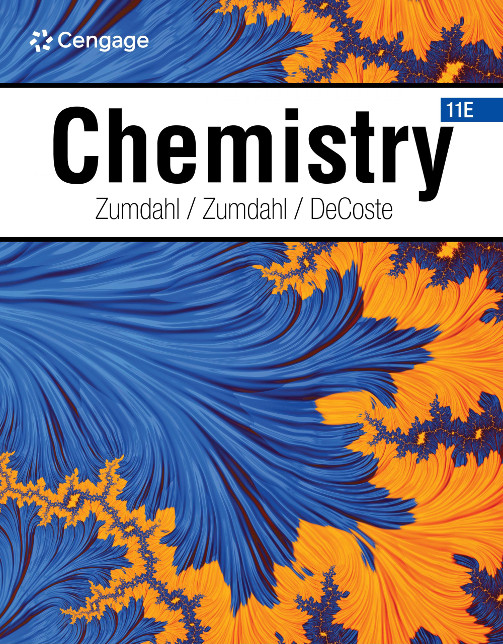SN1: General Chemistry homework. |
The problem numbers are based on the Zumdahl 11th Ed. |  |
Week 15 (Nov. 24 - Nov. 28)
10.1 Intermolecular Forces
problem: 45, 49, 55, 56, 57, 58
10.9 Phase Diagrams
problem: 127, 129
Week 14 (Nov. 17 - Nov. 21)
9.1 Hybridization and the Localized Electron Model
problem: 27, 29, 31, 37, 39, 40, 41, 47, 48, 49, 53, 54, 55, 75
10.1 Intermolecular Forces
problem: 45, 49, 55, 56, 57, 58
10.9 Phase Diagrams
problem: 127, 129
Week 13 (Nov. 10 - Nov. 14)
8.13 Molecular Structure: The VSEPR Model
problem: 133, 134, 135, 143, 145, 146, 147
Week 12 (Nov. 3 - Nov. 7)
8.10 Lewis Structures + simple polymers
problem: 93, 97
problem: 115, 119
8.11 Exceptions to the Octet Rule
problem: 101
Week 11 (Oct. 27 - Oct. 31)
7.12 Periodic Trends in Atomic Properties
problem: 119, 123, 133,
135
8.1 Types of Chemical Bonds
8.2 Electronegativity
problem: 33
8.3 Bond Polarity and Dipole Moments
problem: 35, 39, 45
8.4 Ions: Electron Configurations and Sizes
problem: 53, 55, 57, 59, 63
8.6 Partial Ionic Character of Covalent Bonds
8.7 The Covalent Chemical Bond: A Model
8.9 The Localized Electron Bonding Model
Week 10 (Oct. 20 - Oct. 24)
7.11 The Aufbau Principle and the Periodic Table
[ TEST 2 ]
Week 9 (Oct. 13 - Oct. 17)
7.5 The Quantum Mechanical Model of the Atom
7.6 Quantum Numbers
problem: 81, 85
7.7 Orbital Shapes and Energies
problem: 87, 91
7.8 Electron Spin and the Pauli Principle
problem: 93
7.9 Polyelectronic Atoms
problem: 97, 103, 107, 111, 113
Week 8 (Oct. 6 - Oct. 10)
7.1 Electromagnetic Radiation
problem: 51, 53, 57, 159
7.2 The Nature of Matter
problem: 59, 62, 65, 67
problem: 69, 71, 73, 78 , 186
Week 7 (Sept. 29 - Oct. 3)
4.6 Describing Reactions in Solution
problem: 65, 69
4.5 Precipitation Reactions
problem: 59, 61
4.7 Stoichiometry of Precipitation Reactions
problem: 73
4.9 Oxidation-Reduction Reactions
problem: 31,
97
, 99, 103 (Chapter 18: 21, 22, 23)
4.10 Balancing Oxidation-Reduction Equations
problem: 105, 107 (Chapter 18: 25)
Week 6 (Sept. 22 - Sept. 26)
4.2 The Nature of Aqueous Solutions: Strong and Weak Electrolytes
problem: 4,
23
, 33, 37
4.3 The Composition of Solutions
problem:
11
,
12
, 14, 39, 41, 43, 45, 51, 53
4.4 Types of Chemical Reactions
4.8 Acid-Base Reactions
problem:
83
, 85, 89, 91, 96
Week 5 (Sept. 15 - Sept. 19)
3.11 The concept of Limiting Reagent
problem: 133, 137, 142
5.4 Gas Stoichiometry
problem: 73,
75
, 77
, 81
, 83
, 87
5.5 Dalton's Law of Partial Pressures
problem:
95
, 109
[ TEST 1 ]
Week 4 (Sept. 8 - Sept. 12)
3.4 Molar Mass
3.6 Percent Composition of Compounds
problem: 75,
79
, 85
3.7 Determining the Formula of a Compound
problem: 87, 89, 93,
95,
97, 99,
105
3.8 Chemical Equations
3.9 Balancing Chemical Equations
problem: 111, 112
3.1 Stoichiometric Calculations: Amounts of Reactants and Products
problem: 119, 121, 123,
127
Week 3 (Sept. 1 - Sept. 5)
3.2 Atomic Masses
Problem: 39,
3.3 The Mole / 3.4 Molar Mass
Problem: 47, 49, 54, 55, 57, 59, 65, 71, 73, 76, 77
Week 2 (Aug. 25 - Aug. 29)
2.5 The modern view of atomic structure: an introduction
problem: 71, 75, 77, 79, 81
2.6 Molecules and ions
Problem: 83
2.7 An introduction to the periodic table
Problem: 65
2.8 Naming simple binary compounds
Problem: 85, 87, 89, 93, 95, 97, 99, 119
Week 1 (Aug. 20 - Aug. 22)
Significant figures and calculations
chap.1 #
34,
38, 42, 44,
54,
66